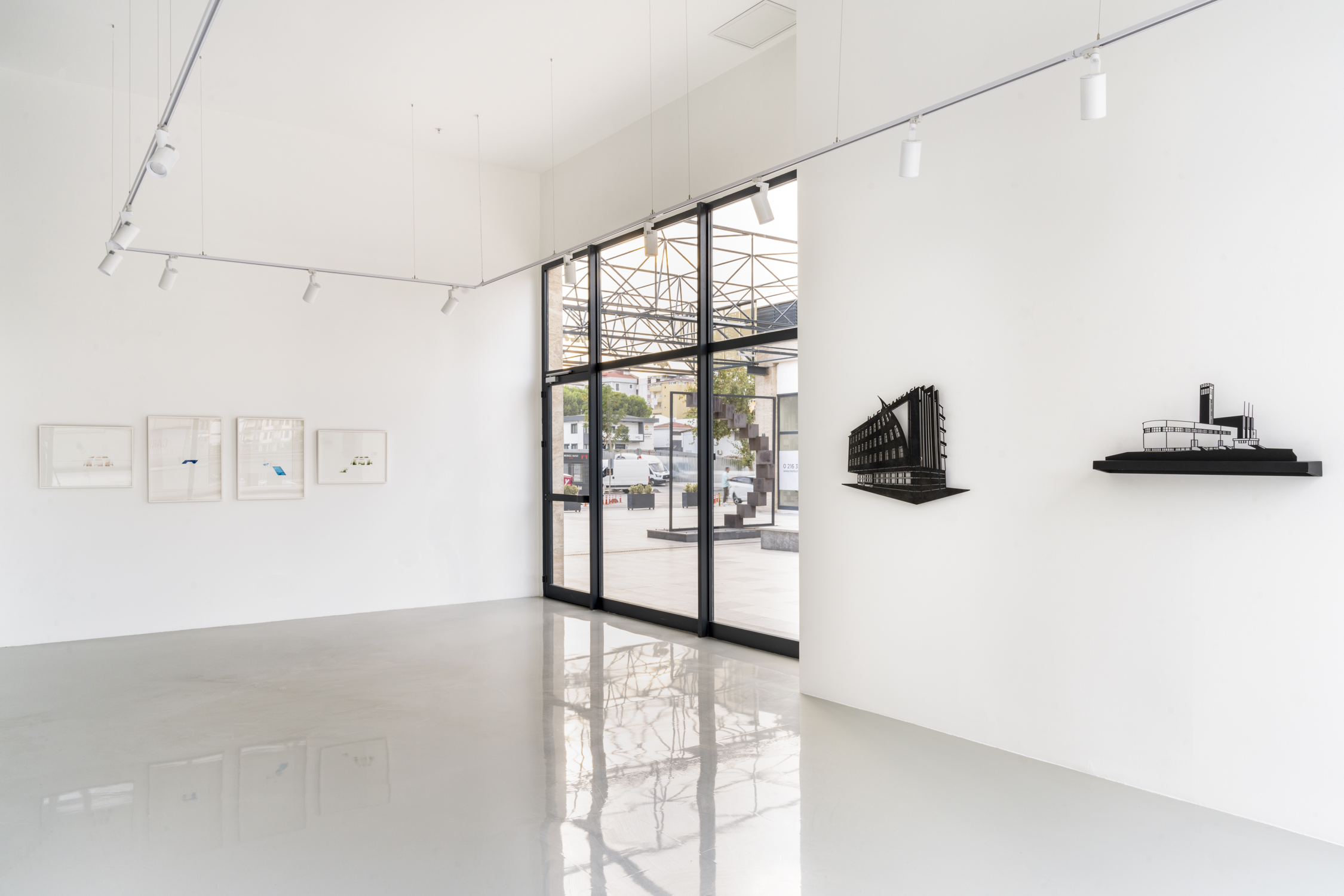Curated by Murat Germen, the exhibition “2.5B” explores the concept of two and a half dimensions—a method of representation that exists between two-dimensional and three-dimensional space, with a focus on the illusion of depth. The exhibition features works by artists Tanzer Arığ, Gökçen Ataman Tanyer, Nora Byrne, Gizem Çeşmeci, Nermin Er, and Semih Zeki. It will be on view at YUNT from September 21 to December 6.
How do you define the concept of “two and a half dimensions”, which is the focal point of the exhibition? What are the inspirations behind this concept?
If we start from the very beginning, the phenomenon of representation forms the source of the concept. Two-dimensional visual depictions (painting, drawing, photography, video, certain computer graphics, etc.) and three-dimensional visual works (sculpture, installation, ready-made/found objects, etc.) are two ends of the concept of representation. I see the concept of “two and a half dimensions” as a purgatory. It is an independent, unique, original and unprecedented form of representation that feeds on both ends, but does not “owe” anything to either of them. Although I don’t see it as exactly the same thing, it is quite identical to the concept of relief art. It is not very dependent on the material; it is possible to produce 2.5-dimensional works with any material such as paper, cardboard, wood, metal, stone, string, etc.
Even in architecture, which we perceive as entirely three-dimensional, we can come across two-and-a-half-dimensional details. For example, it can appear as a cladding layer integrated into a load-bearing wall such as a pilaster (embedded column/wall) with relief ornamentation on; or as a purely decorative plane integrated into a load-bearing column, giving the appearance of a fluted column.
What considerations did you take into account while constructing the 2.5B exhibition? How do the works in the exhibition reflect this construction?
I created works that could be included in the concept of two and a half dimensions. I believe that some of the works by artists whose work I admire, although they may not explicitly claim to be created within this framework, also fall under this category. In order to explain the framework well, I first wrote the concept text and attached it to the invitation message I sent to the artists. None of the artists I contacted turned down my offer; I am sincerely grateful. In this way, the fiction in my head could be materialized in the way I desired. I hope that the notion of two and a half dimensions, which I have presented as the title of the exhibition, will create a ground for reflection during and after the exhibition.
Layers created on top of each other that are not completely covering each other are essential for 2.5 dimension creations. The stacking of ready-made/found objects that contain planes that can be considered two-dimensional can enable the creation of unique micro-universes. Sometimes I consider the revealing of “shadow layers” with the proper lighting of works designed as a single layer and hung on the wall at a distance of 5-10 cm as another method of dimensioning. Because we cannot make a similar shadow-light extension in painting, drawing or photography. I chose the works of the artists I invited with this in mind.

In one of your works, you mention that photography can be used as a two-dimensional tool to create three-dimensional structures. Are the works in the exhibition influenced by this view?
Yes, completely. That’s why when I was offered to curate an exhibition at YUNT, I proposed this concept that has been occupying my mind for a while, and after the YUNT team agreed, I started to approach the artists.
By the way, I don’t claim to be a curator, I would like to emphasize that. Unfortunately, curatorship these days has mostly been reduced to the act of bringing together friends and “buddies” with whom you hang out in exhibitions. Prior to this exhibition, I didn’t want to call myself a curator for this reason in the exhibition “Yesterday – Today – Istanbul”, which opened at Sakıp Sabancı Museum in 2021 with the commission of the director/curator Nazan Ölçer, where I brought together Sabancı University graduates and received positive comments, and they understood. In the exhibition at YUNT, especially after I designed Gizem Çeşmeci’s multi-piece installation – with her permission – with a new layout after 10 hours of effort, I think I somehow deserved the title of curator.
How do you interpret the relation between the works in the exhibition and the material / surface? In particular, how is the viewer’s perception of space structured in the process of creating two and a half dimensional representations by pushing the limits of the material?
When it comes to the viewer’s perception, it is possible to say that two and a half dimensions partially coincide with three dimensions. In both kinds of display, when the viewer moves, the content they see changes. Therefore, designing the material-surface combination according to this phenomenon can yield good results, which I think some of the artists have taken into consideration. As for the perception of space, spatiality and volume, the compulsory visual fidelity and precision in the Western understanding of perspective is not sought here. Rather, I think the intention is to convey a subjective, deliberately distorted depiction, as in miniatures or M. C. Escher drawings. In other words, what already exists is not represented; on the contrary, a “fresh” entity that has never been represented before is created. And this is a result that art always aims for.

While the world of art and science is focusing on exploring and analyzing beyond the third dimension, why are you exploring the in-between point of the second and third dimension?
I’m not sure we even fully grasped the two-dimensional representation, let alone two and a half dimensions. Pretending that everything is over and moving on to new dimensions, and presenting some rules, theories, actions and methods produced with very subjective goals and perceptions as objective/global truths is one of the most common agenda-changing tactics used by consumption-oriented capitalism. I see a problem in accepting these as unchangeable dogma and attempting to “discover beyond” just because what has been written has been written, and what has been spoken has been spoken. Much has been written on two and three dimensions, but this has mostly been done by middle-aged/old men of colonialist, imperialist countries. No effort was made to find out what Easterners, Middle Easterners, Far Easterners, children, women think about these issues. Those who see progress solely as technological development tend to “explore beyond”. However, when we look at the recent horrific crimes against humanity, it does not seem that we have traveled even “one step further” since the Middle Ages…
What kind of interaction do you hope for between the visitors and the works in the 2.5B exhibition? Can the two-and-a-half dimension become a concept that viewers can recognize in their daily lives, or does it require a careful eye to observe the existence of this in-between dimension?
To put it frankly, I don’t expect a particular interaction but I would like to raise questions in the viewers’ minds about concepts of representation, perception, dimension, layer, depiction, transformation, transmission, representation, observation, disrupting familiarity, etc.
When it comes to the creation of imaginary spaces, the concept of “liminal space” has recently been brought up frequently. What can we conclude when we compare the concept of two and a half dimensions with other alternative dimensional spaces?
First of all, it should be noted that two and a half dimensions is an uninhabitable dimension. When I think of space, livability comes directly to mind. Remembering the architect Lebbeus Woods, whose architectural/urban paintings I admire have not been built, or Giovanni Battista Piranesi, whose great engravings have not been materialized, we can see the spaces they envisioned as imaginary or “liminal”. From this perspective, we can consider such spatial productions to be distantly related to the concept of two and a half dimensions. In both cases, a three-dimensional perception, conception, depiction, suggestion is made, but this suggestion never turns into reality/three dimensions.











